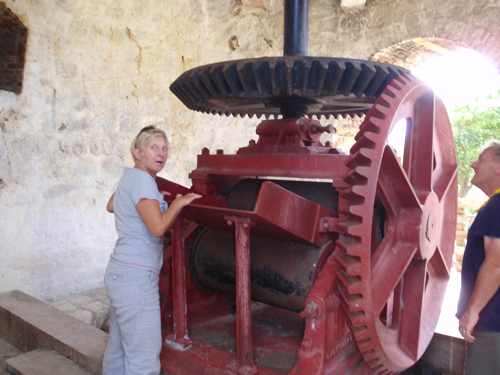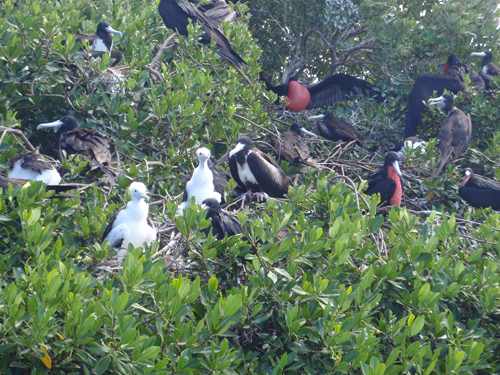Update

Halsway Grace
Robin and Sue carter
Tue 14 Feb 2012 16:35
|
Halsway Grace is again in Jolly Harbour, Antigua, an island we have been in
and around since 24th Jan so we feel we know it quite well. Unlike the other
islands where most of the safe anchorages are on the west coasts, Antigua has
coral reefs which give protection from the Atlantic so it is possible to
circumnavigate the island although we hav’nt had the courage to cover more than
half. The charts of the reefs make Bristol Max look like child play. We were
lucky to have Paul and Penny Jackson to stay with us and as well laughing
the whole week we toured the island visiting a partly restored sugar plantation
and Nelson’s dockyard which has been beautifully renovated. We managed a sail to
Nonsuch Bay on the east coast and hid behind a reef in calm waters,
snorkelling and swimming. The recent yacht wreck left on the reef was a little
disconcerting. There are lots of wonderful anchorages, usually with only 3 or 4
other boats in them but they are dependent on wind and wave swell, we are in a
marina at the moment due to a 3 metre swell which manages to find it’s way in to
even the most sheltered bay and can cause a lot of damage.
BARBUDA
We have just returned from a trip to Antigua’s sister island, 25 miles to
the north and off the beaten track. It is rarely visited by yachts as there is
no marina or harbour for shelter and we spent 3 days at anchor on what feels
like a very remote island. Although only slightly smaller than Antigua, much of
it is covered by a lagoon and there are only 1500 inhabitants, most of whom live
in the only village of Codrington. There are a handful of exclusive resorts
dotted around the coast (too exclusive for mere yachties to be allowed in) It is
surrounded by miles of white sandy beaches and lots of reefs. We were intrigued
to visit because our friend, Mary Carpenter worked here with VSO many years ago
and described it last time we met her with the Victoria Hash House Harriers. We
are so glad we went. The island is very low lying and not visible until about 5
miles off. The highest point is 125 feet and called ‘the Highlands’! we first
anchored off the west coast’s 11 mile long beach that is tinged with pink from
the broken coral. From here we took a water taxi ride from the other side of the
beach across the lagoon to Codrington, named after the English man who rented it
from the British for the price of 1 fattened sheep per year in the 17 century.
Sugar was not grown here but it was used to grow arable crops and keep livestock
and used for hunting by Codrington and his mates. The slaves here were less
supervised than on other islands and our guide proudly told us that slaves were
bred here because they were tall and very strong, he is one of the descendants
(a big guy) and apparently there are only about half a dozen surnames on the
island, descendants of those original slaves. After Codrington, George Jeffries
took us on a tour of the largest colony of Magnificent Frigate Birds. It was a
fast water taxi ride up to the mangroves in the north of the lagoon and then a
slow punt past them all at very close quarters. We were lucky to visit during
the mating season when the males puff up their breasts into bright red balloon
like pouches. These birds are huge with a wing span of 2.5 metres and
cannot land on water because they would be unable to take off again. their diet
is flying fish! There were many chicks who fledge at 5 months old and they were
all totally unperturbed by our presence. They make a clicking noise but there is
little other noise. There are 2-3, 000 pairs here all closely packed
together.
After this wonderful trip with our inspiring guide we moved to the south
coast and sat at anchor between reefs with lots of turtles swimming around in
crystal clear water where we could see all the giant starfish on the seabed.
It is a rare unspoilt island and the locals are keen to keep it this way
without the trappings of our modern lives, good for them.
We are now moving south again to meet Florence and Philly in Granada at the
end of March. We will try to visit what is left of volcanic Montserrat on our
way there.
We are attaching a couple of photos, there is one of the London made
milling machinery at the sugar plantation for extracting sugar juice from the
cane. the other is of the Frigate Bird Colony
Best wishes to you all
Sue and Robin
|

